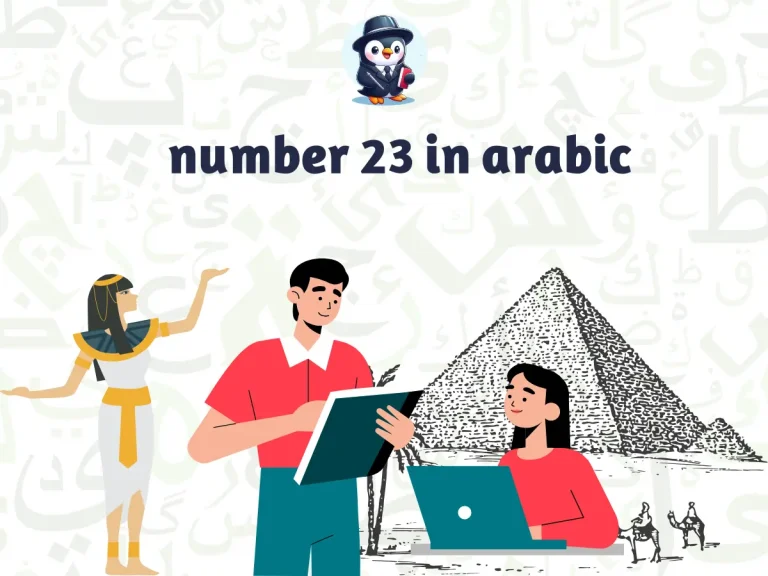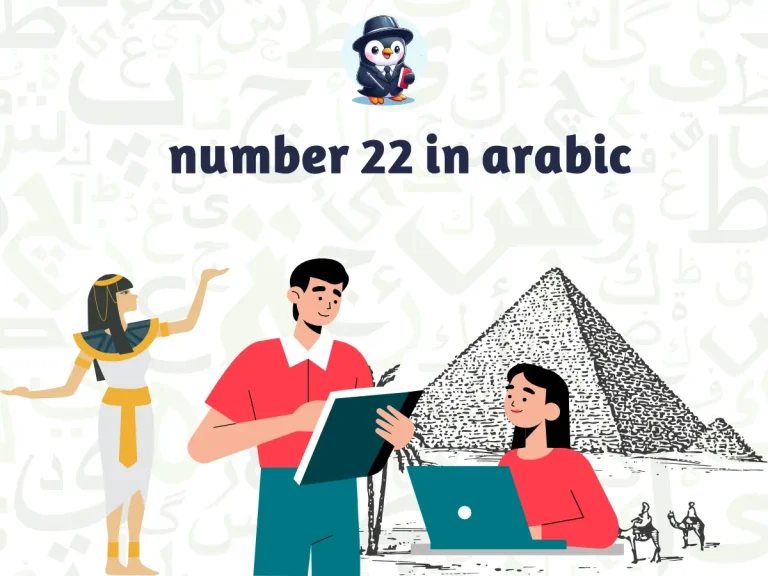number 10 in arabic pronunciation & writing
The number 10 in arabic, “ʿasharah” (عشرة), holds a central position in the Arabic language, acting as a cornerstone for counting and influencing the formation of other numbers.
To learn more about the rest of the numbers from 1 to 100, you can visit this link: Arabic numbers 1 to 100
Here’s a deeper look at the importance and diverse uses of “ʿasharah”:
number 10 in arabic: Foundational for Counting
ʿAsharah forms the base for counting higher numbers. It’s the first “milestone” after the single digits and serves as a reference point for quantities beyond nine.
From counting vegetables at the market (“ʿasharah kiloghrāman min al-banādhir” (عشرة كيلوغرام من الباذنجان) – Ten kilograms of eggplants)
to expressing age (“al-walad ʿashara aʿوام” (الولد عشر أعوام) – The boy is ten years old), “ʿasharah” is fundamental for everyday communication.
number 10 in arabic: Building Block for Other Numbers
“ʿasharah” plays a crucial role in forming numbers from eleven to nineteen. Unlike English, Arabic uses a different system for these numbers. Ten combines with the previous single digit.
For example, “khamsat ʿasharah” (خمسة عشرة) means fifteen (literally “five ten”). This system, based on “ʿasharah,” adds another layer of complexity and nuance to Arabic numbers.
number 10 in arabic: Linguistic Influence
“ʿasharah” acts as a root for other words. The root “ʿ-sh-r” carries the concept of “ten” or “tenth.” This root gives rise to words like “ʿishrun” (عشرون) meaning “twenty” and “ʿishrinī” (عشريني) meaning “in my twenties.
Understanding the root allows you to connect numbers to related vocabulary, enriching your understanding of the language.
number 10 in arabic: Historical Significance
Dates on historical buildings or documents are often written in numerals. Knowing Arabic numerals, including “ʿasharah,” allows you to decipher these inscriptions, unlocking a window into the past.
For example, an inscription mentioning the founding of a mosque in “sanat ithnatayn wa ʿishrīn” (سنة اثنتين وعشرين) refers to the year 22 in the Hijri calendar.
By appreciating the importance of “ʿasharah,” one gains a deeper understanding of the structure and logic of the Arabic number system.
It’s a number that transcends mere counting, forming the backbone for higher numbers and influencing related vocabulary.
Understanding “ʿasharah” allows you to navigate everyday communication, connect with Arabic culture and history, and appreciate the intricate beauty of the language.
Demystifying Arabic numbers
Numbers are the building blocks of communication in any language, but in Arabic, they hold a deeper significance.
From navigating daily interactions to unlocking cultural nuances, mastering Arabic numbers is an enriching journey.
Let’s delve into the importance of learning numbers and explore the fascinating number four, “arbaʿah” (أربعة).
?Why Learn Arabic numbers
Numbers are crucial for navigating everyday life in Arabic-speaking regions. Shopping in a market (“urid arbaʿah kilogramm min al-limun” (أريد أربعة كيلوغرام من الليمون) – I want four kilograms of lemons),
asking for directions (“al-bank ayn?” (البنك أين؟) – Where is the bank?), or simply telling the time (“al-muḥadarah tibdaʿ fi al-saaʿah al-raabiʿah” (المحاضرة تبدأ في الساعة الرابعة) – The lecture starts at four o’clock) – Arabic numbers are key to successful communication.
10 in arabic numbers: A Gateway to Culture
Arabic culture is rich with symbolic numbers. Understanding numbers allows you to grasp cultural references.
For example, the four elements (earth, air, fire, water) are a recurring theme in Arabic literature and philosophy. Recognizing the number four helps you connect the dots.
10 in arabic numbers: Deciphering the Past
Dates on historical buildings and documents are often written in numerals. Knowing Arabic numbers allows you to decipher these inscriptions, offering a glimpse into the past.
The Enigmatic Four: Arbaʿah
The number four is more than just a numeral in Arabic. It holds a unique place, demonstrating the intricate connection between numbers and other aspects of the language
Distinctive Use: Unlike English, Arabic has two main ways to express numbers from eleven to nineteen.
Four doesn’t directly combine with “ten” (“ʿasharah” (عشرة)) to form a new number.
Instead, numbers like fourteen use a separate construction involving the word “fuq” (فوق) meaning “above.” For example, “arbaʿah fuqa ʿasharah” (أربعة فوق عشرة) signifies fourteen.
Linguistic Peculiarity: The pronunciation of “arbaʿah” (أربعة) involves a unique sound not present in English.
The letter “ʿayn” (“ع”) creates a guttural sound at the back of the throat. While unfamiliar at first, practice can help you master it.
Embracing the Journey of Numbers
By mastering numbers in Arabic, you unlock a deeper appreciation for the language’s complexity and its connection to the culture it serves.
From navigating daily situations to understanding historical references, numbers become more than just symbols – they become tools to connect with the Arabic world on a deeper level.
So, embark on the rewarding journey of learning Arabic numbers, and watch your comprehension of the language and its cultural tapestry expand.
Writing and Pronouncing ʿAsharah – 10 in arabic numbers
The number ten, “ʿasharah” (عشرة), occupies a central position in the Arabic language.
It’s not just the base for counting higher numbers; it plays a crucial role in forming other words and serves as a key to understanding the Arabic number system.

Here’s a breakdown of how to write and pronounce “ʿasharah”:
Writing ʿAsharah
- Individual Letters: Ten Arabic letters make up “ʿasharah”:
- ع (ʿayn): Represents a voiceless pharyngeal consonant, a guttural sound not present in English. It’s similar to the French “r” in the word “heure” (hour).
- ش (shīn): Represents a voiceless postalveolar fricative sound like the “sh” in “ship.”
- ر (rāʾ): Represents a voiced uvular trill sound, a vibrating sound at the back of the throat (similar to a rolled “r” in some languages).
- ة (taa marbutah): This silent ending indicates the grammatical function of the word in a sentence (usually feminine singular here).
| Pronunciation | Arabic | English |
|---|---|---|
| ʿashara | عشرة | ten |
| ihtiyaju ila ʿashara daqaaʾiq li-akmil wageby | أحتاج إلى عشرة دقائق لأكمل واجبي | I need ten minutes to finish my homework. |
Pronunciation: ʿA-sharah (emphasis on “a”
- First Syllable (“ʿA”): The “ʿayn” creates a guttural sound at the back of the throat. If unfamiliar, try making a choking sound without actually choking.
- Second Syllable (“sha-rah”): Pronounce the “sh” clearly, followed by a short “a” sound and a rolled “r.”
Tips for Mastering ʿAsharah
- Listen and Repeat: Listen to native speakers pronounce “ʿasharah” and then try replicating the sound, focusing on the guttural “ʿayn.”
- Use Online Resources: Many online resources offer audio recordings and pronunciation guides for Arabic numbers.
- Shadowing Technique: Listen to a native speaker counting to ten and then repeat simultaneously, mimicking their pronunciation.
Dialectal Variations
While the core pronunciation remains similar across Arabic dialects, there might be slight variations in emphasis or the “ʿayn” sound:
- Egyptian Arabic: The emphasis might shift slightly, with a shorter “a” sound in the “sha-rah” syllable.
Examples in Dialects
- Modern Standard Arabic: ʿAsharah (عشرة)
- Egyptian Arabic: ʿAshra (عشرة) (shorter “a” sound)
number 10 in arabic: Beyond Pronunciation
Remember, “ʿasharah” forms the base for numbers eleven to nineteen in Arabic. It combines with the previous single digit using the word “fuq” (فوق) meaning “above.” For example, “khamsat ʿasharah” (خمسة عشرة) means fifteen (literally “five above ten”).
By understanding how to write and pronounce “ʿasharah” and its role in forming other numbers, you’ll be well on your way to mastering the Arabic number system and unlocking a deeper level of communication in the language.






